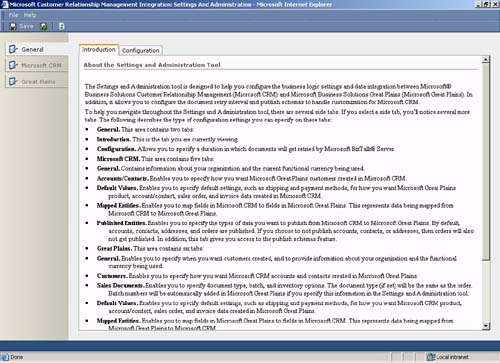Integration Components
In addition to the BizTalk Server 2002 Partner Edition software, the Microsoft CRM Integration utilizes several additional components to integrate Microsoft CRM with Great Plains.
One major component that is installed with BizTalk Server is the Document Exchange (DX). DX is comprised of three parts, database tables, triggers, and Microsoft SQL Server Data Transformation Services (DTS) packages. Triggers are scripts that are run in response to an action taken on a database table. An example of an action would be updating a customer record. DTS packages can be used to automate the manipulation of data residing in SQL Server. DX uses these three parts to monitor and respond to changes made to data residing in Great Plains.
Microsoft CRM Integration and BizTalk Server 2002 make use of Microsoft Message Queuing (MSMQ). MSMQ comes with Windows 2000 Server and must be installed and configured prior to installing the Microsoft CRM Integration. MSMQ provides applications with a guaranteed delivery system for messages and works similarly to email. With email, one user sends a message and the message stays in an inbox until the receiver is ready to read it. MSMQ allows Microsoft CRM and DX to send messages (data) to an inbox (a queue) for BizTalk Server to read when it is ready.
The Microsoft CRM Integration also installs a Settings and Administration tool. This tool provides a user interface to configure how/what data is moved between Microsoft CRM and Great Plains. Figure 13.1 shows the Settings and Administration tool. Notice that it has the Microsoft CRM look and feel and includes separate tabs for the Microsoft CRM and Great Plains settings. This tool is actually a separate Web site that is installed on the Microsoft CRM integration computer.
Figure 13.1. The introductory page of the Microsoft CRM Integration Settings and Administration tool.

The Settings and Administration tool enables the integration administrator to configure settings including
When a Great Plains customer is created should it be added to Microsoft CRM as an Account or a Contact (in other words is your organization operating under a B2B or B2C model)?
What are the default values for these newly created Accounts or Contacts (for example, what type of customer is it, what is the customer's preferred shipping method, etc.)?
How do similar fields in Microsoft CRM map to those in Great Plains? (For instance, Net 30 terms in Microsoft CRM might be equal to two percent 10/Net 30 in Great Plains.)
After these settings are configured, the integration is ready to transfer data on an ongoing basis between Microsoft CRM and Great Plains. One thing to note, however, is that there are some initial data elements that need to be converted from Great Plains to Microsoft CRM prior to turning on the integration. For example, the master list of Great Plains products needs to be added to Microsoft CRM before using the integration. More on this later.
